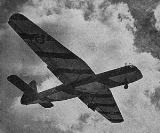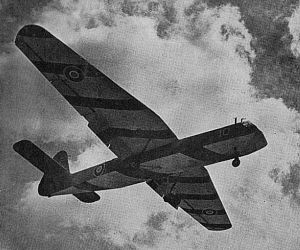
Air Landing Regiment
Encyclopedia
An Air Landing was the term used for British Army
, glider-borne troops. Air Landing units included infantry battalions and light armoured regiments together with combat support and combat service support units and sub-units. The Glider Pilot Regiment
provided the aircrew to fly the gliders into battle (who were trained to fight alongside them on the ground thereafter). Although combat support and combat service support units had the term 'Air Landing' as part of their unit title, for example 53 Air-Landing Regiment, Royal Artillery infantry battalions names remained unchanged. All units wore the maroon beret
of airborne forces with their own capbadge.
 The Air Landing Brigades formed an integral part of the 1st and 6th Airborne Divisions. Paratroopers tended to become scattered over a wide area on landing. This meant they took some time to compose a useful force, once on the ground. Although gliders needed a certain amount of ground to land the soldiers aboard arrived in larger groups (the Horsa
The Air Landing Brigades formed an integral part of the 1st and 6th Airborne Divisions. Paratroopers tended to become scattered over a wide area on landing. This meant they took some time to compose a useful force, once on the ground. Although gliders needed a certain amount of ground to land the soldiers aboard arrived in larger groups (the Horsa
glider carried a complete platoon
ready for combat.
The British Army had been inspired in creating both glider-borne units and parachute units by the example of the German Luftwaffe
's Glider Troops which had played a major role in Germany's invasions of the Low Countries, and Crete.
 Probably the most famous action involving a glider-borne unit was that at Pegasus Bridge
Probably the most famous action involving a glider-borne unit was that at Pegasus Bridge
, the first landing of troops on D Day, as part of Operation Deadstick
. On the night of 5/6 June 1944, D Company, the Second Battalion, Oxfordshire and Buckinghamshire Light Infantry
(2nd Ox & Bucks), together with Royal Engineers
and men of the Glider Pilot Regiment (totalling 181 men), were carried in 6 Horsa gliders to capture the vital bridge (later renamed "Pegasus Bridge
") over the Caen Canal
, and the bridge over the Orne River
(since known as Horsa Bridge, and which is east of Pegasus Bridge). This was intended to secure the eastern flank to prevent German armour from reaching the area behind Sword Beach
and interfering with the beach landings there.
Five of the Ox and Bucks's gliders landed very close to their objectives at 16 minutes past midnight and poured out of their battered gliders, completely surprising the German defenders, and taking the bridges within 10 minutes. They lost two men, Lieutenant Den Brotheridge
and Lance-Corporal Greenhalgh, in the process. One Glider, assigned to the capture of Horsa Bridge, was landed at the bridge over the Rives Dives, some 7 miles from where they were meant to land. Most of the soldiers in this glider and moved through German lines towards the village of Ranville where they eventually rejoined the British forces. The Ox & Bucks were reinforced half-an-hour after the landings by 7th Parachute Battalion, and linked up with the beach landing forces with the arrival of the Commandos
under the command of Lord Lovat
.
British Army
The British Army is the land warfare branch of Her Majesty's Armed Forces in the United Kingdom. It came into being with the unification of the Kingdom of England and Scotland into the Kingdom of Great Britain in 1707. The new British Army incorporated Regiments that had already existed in England...
, glider-borne troops. Air Landing units included infantry battalions and light armoured regiments together with combat support and combat service support units and sub-units. The Glider Pilot Regiment
Glider Pilot Regiment
The Glider Pilot Regiment was a British airborne forces unit of the Second World War which was responsible for crewing the British Army's military gliders and saw action in the European Theatre of World War II in support of Allied airborne operations...
provided the aircrew to fly the gliders into battle (who were trained to fight alongside them on the ground thereafter). Although combat support and combat service support units had the term 'Air Landing' as part of their unit title, for example 53 Air-Landing Regiment, Royal Artillery infantry battalions names remained unchanged. All units wore the maroon beret
Maroon beret
The maroon beret is a military beret and has been an international symbol of elite airborne forces since it was chosen for British airborne forces in World War II. This distinctive head dress was officially introduced in 1942, at the direction of General Frederick Browning, commander of the British...
of airborne forces with their own capbadge.

Airspeed Horsa
The Airspeed AS.51 Horsa was a British World War II troop-carrying glider built by Airspeed Limited and subcontractors and used for air assault by British and Allied armed forces...
glider carried a complete platoon
Platoon
A platoon is a military unit typically composed of two to four sections or squads and containing 16 to 50 soldiers. Platoons are organized into a company, which typically consists of three, four or five platoons. A platoon is typically the smallest military unit led by a commissioned officer—the...
ready for combat.
The British Army had been inspired in creating both glider-borne units and parachute units by the example of the German Luftwaffe
Luftwaffe
Luftwaffe is a generic German term for an air force. It is also the official name for two of the four historic German air forces, the Wehrmacht air arm founded in 1935 and disbanded in 1946; and the current Bundeswehr air arm founded in 1956....
's Glider Troops which had played a major role in Germany's invasions of the Low Countries, and Crete.

Pegasus Bridge
Pegasus Bridge is a bascule bridge , built in 1934, that crossed the Caen Canal, between Caen and Ouistreham, in Normandy, France....
, the first landing of troops on D Day, as part of Operation Deadstick
Operation Deadstick
Operation Deadstick was the codename for an airborne forces operation by the British Army that took place on 6 June 1944 as part of the Normandy landings. The mission's objective was to capture intact two road bridges in Normandy across the River Orne and the Caen Canal providing the only exit...
. On the night of 5/6 June 1944, D Company, the Second Battalion, Oxfordshire and Buckinghamshire Light Infantry
Oxfordshire and Buckinghamshire Light Infantry
The Oxfordshire and Buckinghamshire Light Infantry was an infantry regiment of the British Army.The regiment was formed as a consequence of Childers reforms, a continuation of the Cardwell reforms, by the amalgamation of the 43rd Regiment of Foot and the 52nd Regiment of Foot , forming the 1st...
(2nd Ox & Bucks), together with Royal Engineers
Royal Engineers
The Corps of Royal Engineers, usually just called the Royal Engineers , and commonly known as the Sappers, is one of the corps of the British Army....
and men of the Glider Pilot Regiment (totalling 181 men), were carried in 6 Horsa gliders to capture the vital bridge (later renamed "Pegasus Bridge
Pegasus Bridge
Pegasus Bridge is a bascule bridge , built in 1934, that crossed the Caen Canal, between Caen and Ouistreham, in Normandy, France....
") over the Caen Canal
Canal de Caen à la Mer
Canal de Caen à la Mer also called the "Caen Canal") is a short canal in the department of Calvados, France, connecting the Port of Caen, in the city of Caen, downstream to the town of Ouistreham and the English Channel....
, and the bridge over the Orne River
Orne River
The Orne is a river in Normandy, within northwestern France. It discharges into the English Channel at the port of Ouistreham. Its source is in Aunou-sur-Orne, east of Sées...
(since known as Horsa Bridge, and which is east of Pegasus Bridge). This was intended to secure the eastern flank to prevent German armour from reaching the area behind Sword Beach
Sword Beach
Sword, commonly known as Sword Beach, was the code name given to one of the five main landing areas along the Normandy coast during the initial assault phase, Operation Neptune, of Operation Overlord; the Allied invasion of German-occupied France that commenced on 6 June 1944...
and interfering with the beach landings there.
Five of the Ox and Bucks's gliders landed very close to their objectives at 16 minutes past midnight and poured out of their battered gliders, completely surprising the German defenders, and taking the bridges within 10 minutes. They lost two men, Lieutenant Den Brotheridge
Den Brotheridge
Lieutenant Herbert Denham Brotheridge was a British Army officer, and is often considered to be the first Allied soldier to be killed in action on D-Day, 6 June 1944, during Operation Tonga...
and Lance-Corporal Greenhalgh, in the process. One Glider, assigned to the capture of Horsa Bridge, was landed at the bridge over the Rives Dives, some 7 miles from where they were meant to land. Most of the soldiers in this glider and moved through German lines towards the village of Ranville where they eventually rejoined the British forces. The Ox & Bucks were reinforced half-an-hour after the landings by 7th Parachute Battalion, and linked up with the beach landing forces with the arrival of the Commandos
British Commandos
The British Commandos were formed during the Second World War in June 1940, following a request from the British Prime Minister, Winston Churchill, for a force that could carry out raids against German-occupied Europe...
under the command of Lord Lovat
Lord Lovat
Lord Lovat is a title in the Peerage of Scotland. It was created in 1458 for Hugh Fraser. The title descended in a direct line for nine sequential generations until the death of the ninth Lord in 1696. He was succeeded by his great-uncle, the tenth Lord...
.

